SIP trunking is a modern communication technology that allows businesses to make and receive VoIP (Voice over IP) calls without relying on physical wiring, leading to cost savings and operational efficiency.
Advantages of SIP Trunking
- Cost Savings: By eliminating the need for physical phone lines and associated hardware, businesses can significantly reduce monthly expenses related to line rentals and Direct Inward Dialing (DID) services.
- Scalability: SIP trunks can be easily added or removed to match the changing communication needs of a business, ensuring flexibility and cost-effectiveness.
- Reliability: With an active internet connection, SIP trunking ensures continuous communication, providing a dependable backup in case of traditional landline failures.
- Geographic Flexibility: SIP trunking is not bound by location constraints, allowing businesses to retain their original numbers even when moving offices, thereby maintaining consistency for clients and partners.
- Global Reach: SIP trunks allow businesses to obtain phone numbers from any country in the world, enabling a local presence in international markets without requiring a physical office in those locations.
SIP Trunking with Cloud-PBX
Cloud-PBX is designed to work seamlessly with various ITSPs, offering pre-configured templates and compatibility with numerous providers worldwide. This interoperability simplifies the configuration process, allowing businesses to quickly set up their SIP trunks and enhance their communication infrastructure.
By adopting SIP trunking, businesses can modernize their communication strategies, reduce costs, and enjoy a flexible, reliable, and scalable solution that meets the demands of today’s dynamic work environment.
Flexible Call Routing
With SIP trunking, incoming calls can be intelligently routed to various destinations within your Cloud-PBX system, such as Auto Attendants, Call Queues, individual Extensions, or even external numbers. This ensures that calls are directed to the right department or person efficiently, improving customer experience and operational workflow. Whether a caller needs general assistance, sales, or technical support, predefined routing rules help streamline communication.
Routing can be customized based on multiple factors, including the dialed number (DID), Caller ID, date and time, or special conditions like holidays. For example, calls to a specific DID can be directed to a sales queue during business hours and an after-hours voicemail or answering service in the evening. Likewise, VIP callers can be routed directly to priority support agents based on their caller ID. By leveraging these advanced routing capabilities, businesses can optimize call handling, reduce wait times, and enhance overall customer satisfaction.
